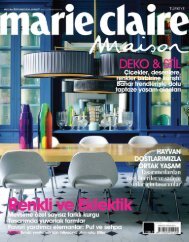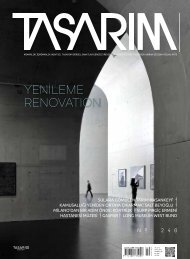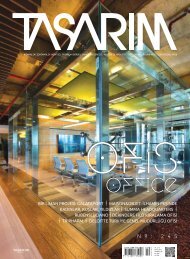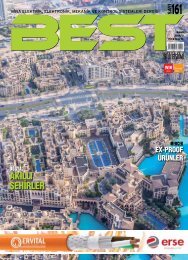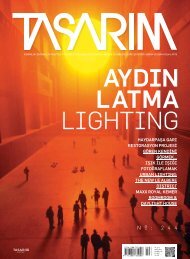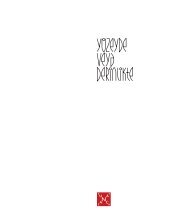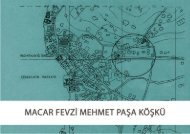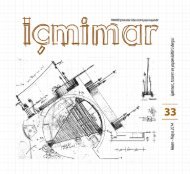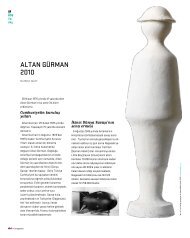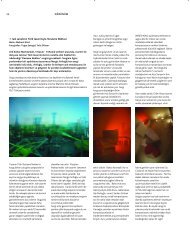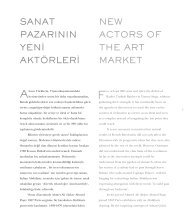SURET-SİZ
Tunca Sanat'ın 15 Aralık 2010 - 30 Ocak 2011 tarihleri arasında düzenlediği “Suret-siz’’ adlı sergisi için Mahmut Nüvit'in kaleme aldığı yazısı...
Tunca Sanat'ın 15 Aralık 2010 - 30 Ocak 2011 tarihleri arasında düzenlediği “Suret-siz’’ adlı sergisi için Mahmut Nüvit'in kaleme aldığı yazısı...
You also want an ePaper? Increase the reach of your titles
YUMPU automatically turns print PDFs into web optimized ePapers that Google loves.
7) Frances Stonor Saunders,<br />
‘Parayı Verdi Düdüğü Çaldı’<br />
(Paid the Piper and Called the<br />
Tune), Doğan Publications and<br />
later Kırmızı Yayıncılık (Kırmızı<br />
Publishing).<br />
Serge Guibaut, ‘New York<br />
Modern Sanat Düşüncesini<br />
Nasıl Çaldı’ (How New York<br />
Stole the Idea of Modern<br />
Art), Soyut Dışavurumculuk,<br />
Özgürlük ve Soğuk Savaş<br />
(Abstract Expressionism,<br />
Freedom and the Cold War),<br />
Sel Yayıncılık (Sel Publishing).<br />
8) Mübin Orhon, Abstract<br />
Composition, 1962,<br />
362X112cm, Kraft-oil on<br />
canvas, Antik Aş, catalogue<br />
for auction of 7 November<br />
2010<br />
was, in the anti-soviet propaganda of the cold war years,<br />
supported by the CIA, which backed abstract art as a<br />
freedom-seeking reaction to socialist realism. 7<br />
Art History teaches that Turkish artists began engaging in<br />
an avant-garde abstract debate with a lag of fifty years. Of<br />
the pioneers in the Turkish abstract, Nejat Melih Devrim was<br />
the first to awaken to abstract art ( in1947). Other artists<br />
who paved the way for abstract painting were Devrim’s<br />
mother Fahrülnissa Zeid (from 1947), Ferruh Başağa (also<br />
after 1947), Cemal Bingöl (from 1948) and Mübin Orhon (in<br />
the early 1950s), the latter two doing geometrical abstract<br />
paintings and toward the late 1950s turning to the drip<br />
technique of the abstract expressionists, 8 Abidin Elderoğlu<br />
with calligraphic experiments (post-1950), Adnan Turani<br />
(also post-1950), İhsan Cemal Karaburçak (from the l950s),<br />
Şemsi Arel with explorations in Islamic calligraphy (1951),<br />
and from 1955 Hakkı Anlı with lyrical abstract paintings. The<br />
Academy abstractionists Zühtü Müritoğlu, Ali Hadi Bara and<br />
Sabri Berkel launched into the abstract beginning in 1950-<br />
51. And a groundbreaking initiative was the exhibition held<br />
in 1953 by Lütfü Günay and Adnan Çoker, for it consisted<br />
entirely of abstract paintings (10-15 February 1953, Faculty of<br />
Letters, Ankara). The figurative-nonfigurative debates within<br />
the Academy were of an extent to comprise an entire article<br />
in themselves.<br />
Of those who preferred abstract art as a more individualistic,<br />
freer and more immanent form of expression, some used<br />
their drawing on the traditional cultural reserve of the nation<br />
as a defense against charges of imitation, and the intellectual<br />
side of these works gained legitimacy from the halfcompleted<br />
Anatolian humanism of Sabahattin Eyüboğlu<br />
and his friends. In an environment of extensive debate, art<br />
had discovered a love of the people. The travels through<br />
the land continued, and slide shows about them were being<br />
given in some homes. Among the important discoveries<br />
was Aşık Veysel. Meanwhile Sabahattin Eyüboğlu held gettogethers<br />
in his home every Monday, where Ruhi Su joined<br />
in with a new way of singing Turkish folk songs. At the same<br />
time Atıf Yılmaz taught Tülay German how to play the saz in<br />
| 17




